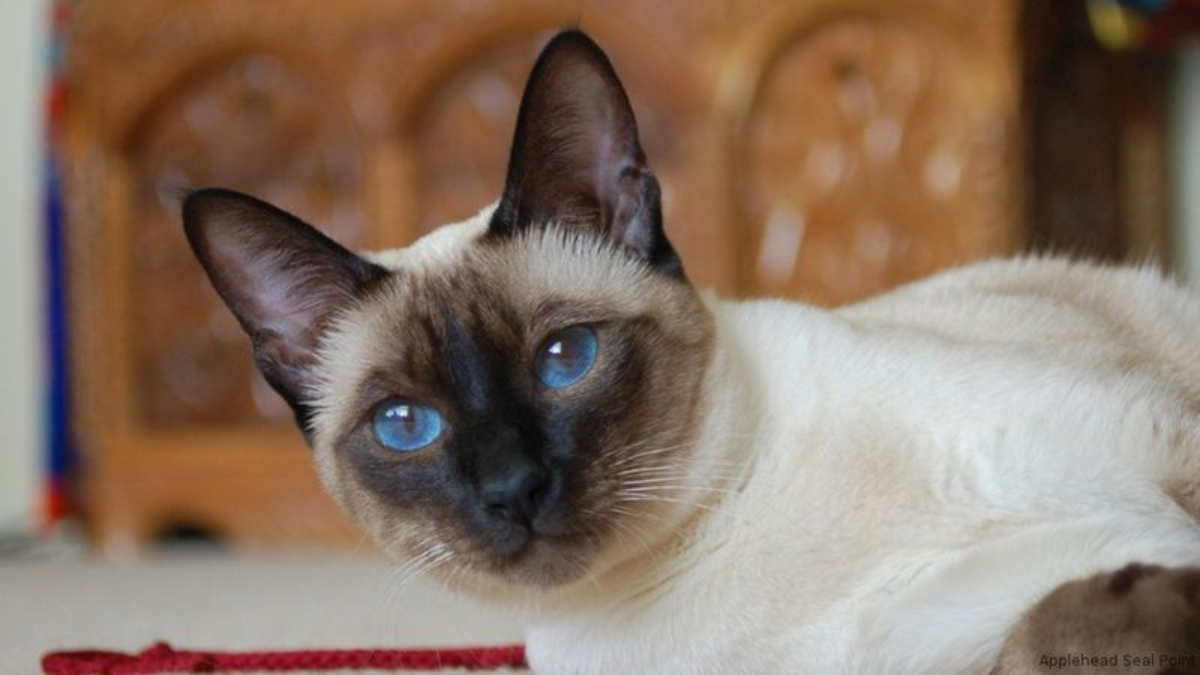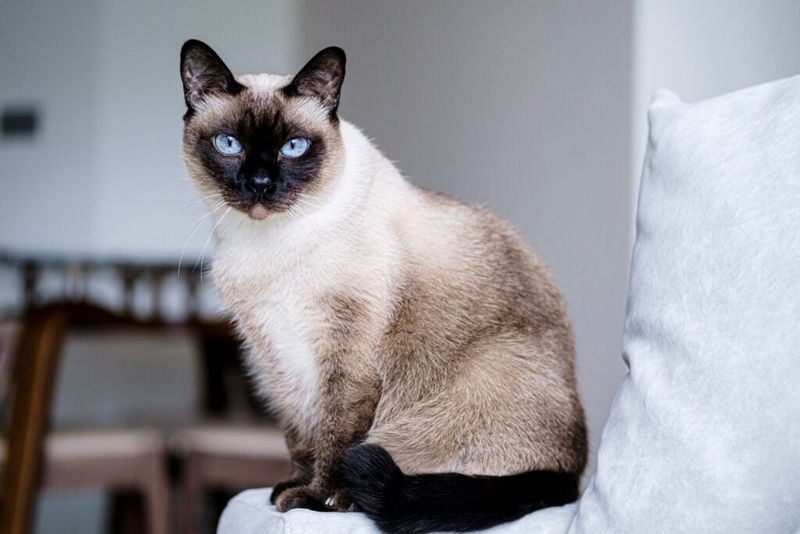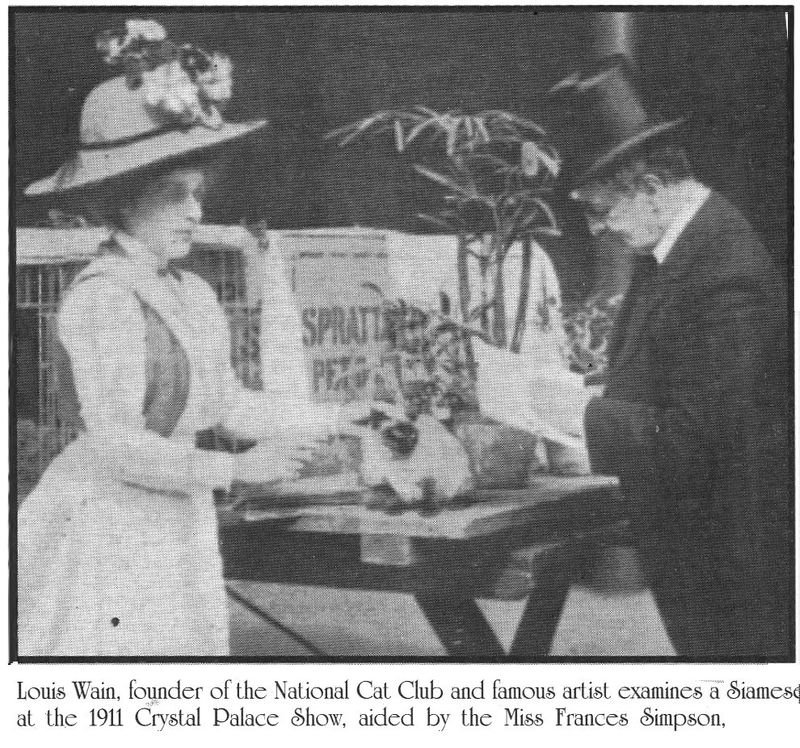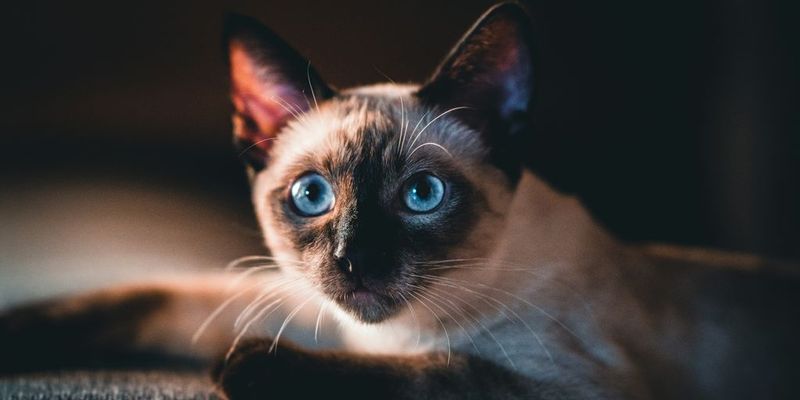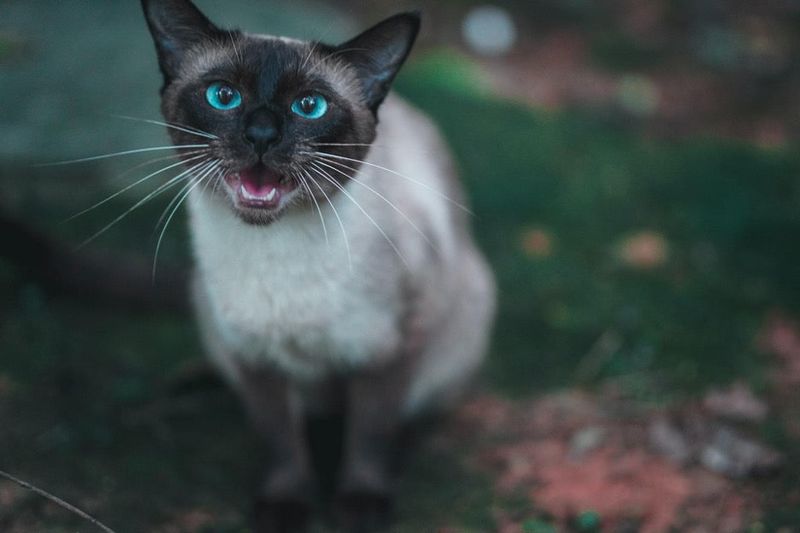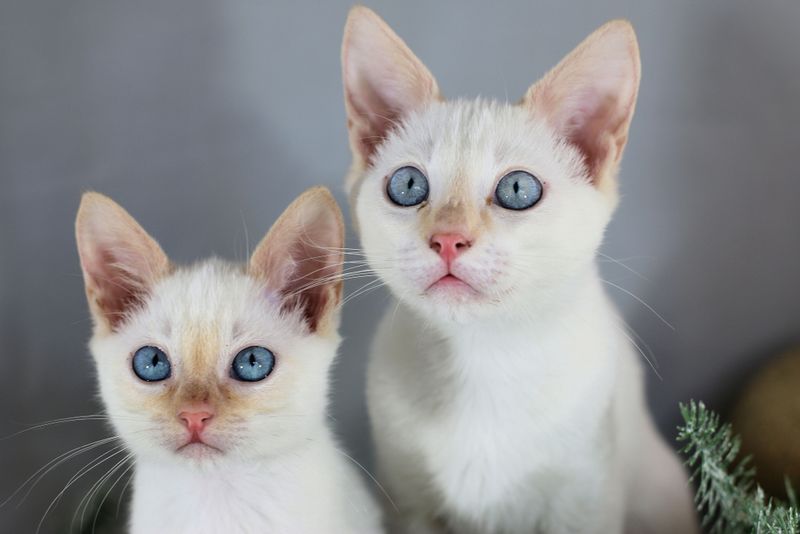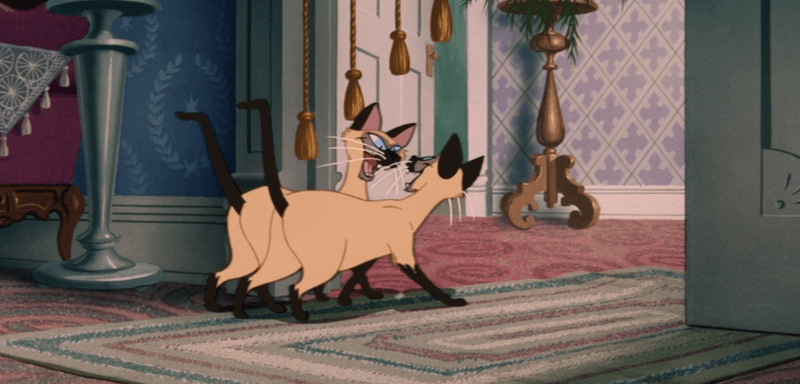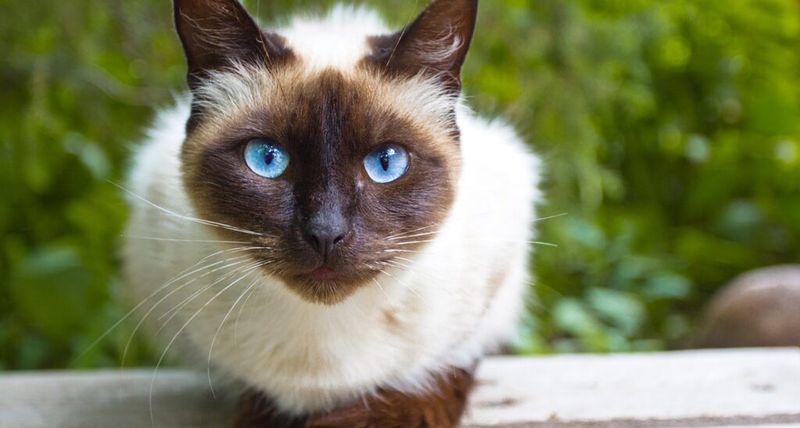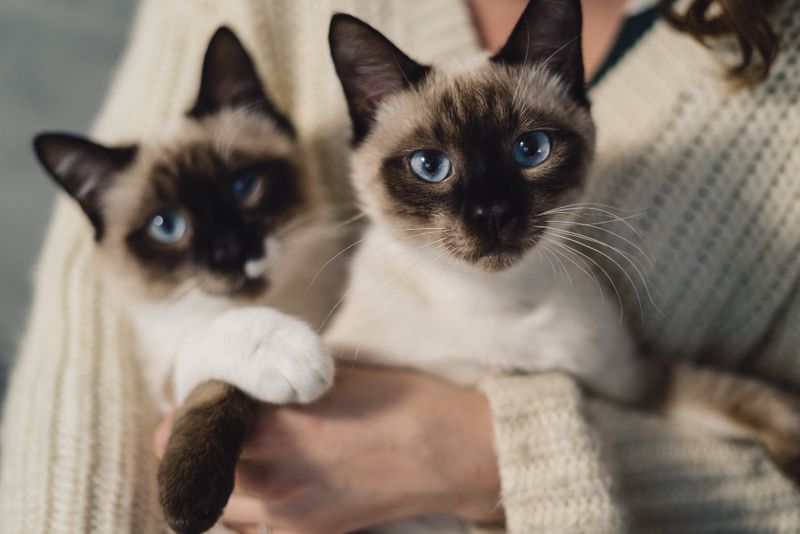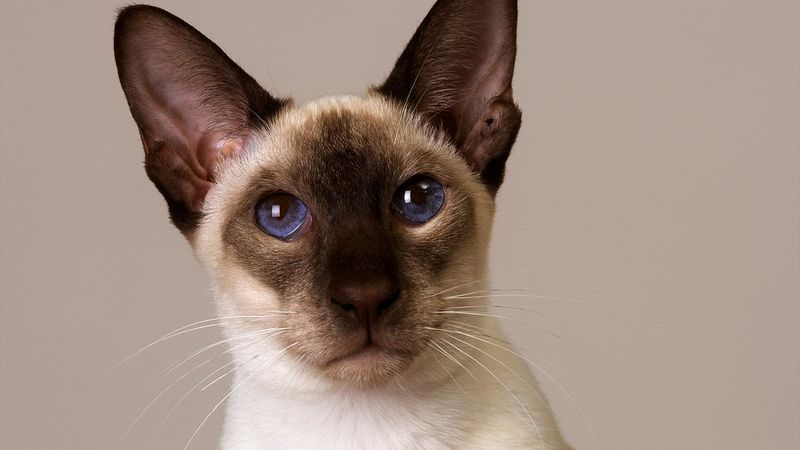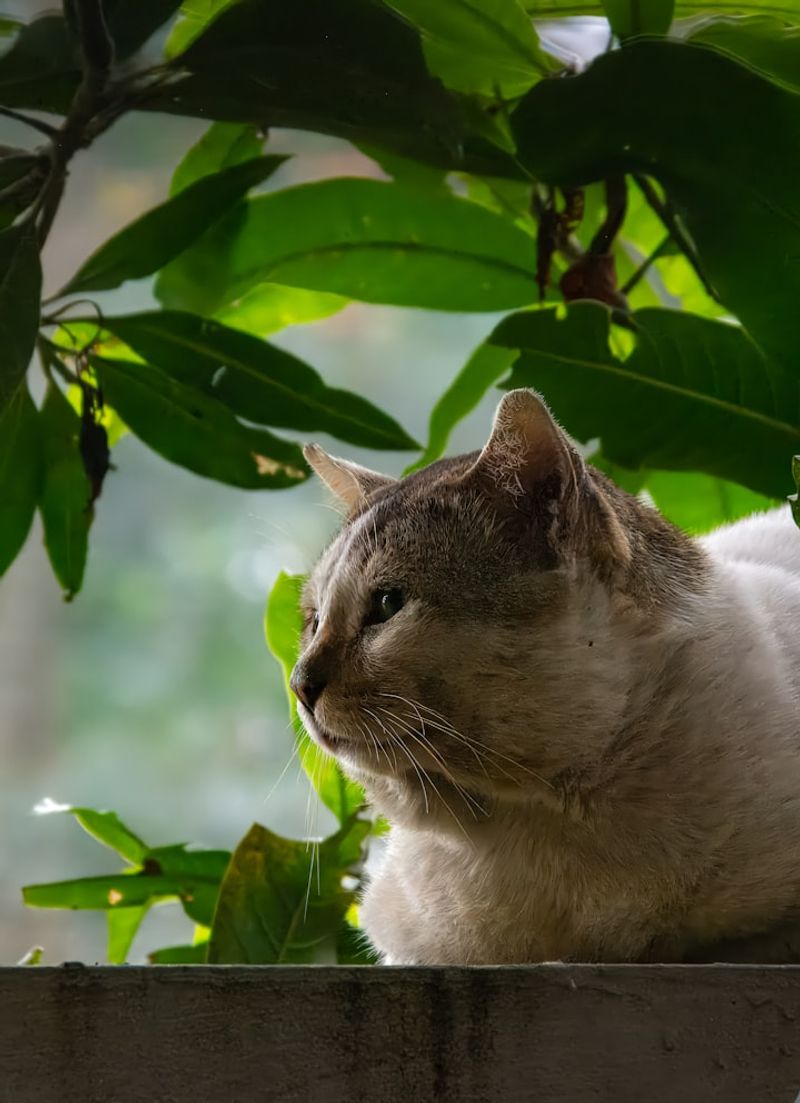📖 Table of Content:
- 1. Royal Origins in Ancient Siam
- 2. The Cross-Eyed Trait
- 3. Temperature-Sensitive Coat Coloring
- 4. First Appearance at the Crystal Palace
- 5. The Legend of the Kinked Tail
- 6. Presidential Pets at the White House
- 7. Extraordinary Vocal Range
- 8. The Four Original Color Points
- 9. Famous Fictional Siamese
- 10. Exceptional Intelligence
- 11. Social Butterflies of the Cat World
- 12. The Modern vs. Traditional Siamese Debate
- 13. Siamese in Scientific Research
- 14. Siamese as Therapy Cats
- 15. Long Lifespan Among Purebreds
Siamese cats are among the most distinctive and admired breeds in the world. Their piercing blue eyes, sleek color-point coats, and elegant frames make them instantly recognizable. This breed’s appearance is as captivating as its personality.
Highly vocal and deeply interactive, Siamese cats are known for forming strong bonds with their human companions. Their expressive nature and intelligence set them apart from more reserved feline breeds. Communication, curiosity, and affection define much of their behavior.
Originating from Thailand, formerly known as Siam, these cats have a rich cultural and historical background. Once considered sacred and reserved for royalty, they carry an air of grace and tradition. Their legacy continues today in homes across the globe, where they are treasured for both their beauty and character.
1. Royal Origins in Ancient Siam
Siamese cats were the treasured companions of Siamese royalty in what is now Thailand. These regal felines lived exclusively in palaces and temples, where they were highly valued for their distinctive appearance and believed to bring good fortune.
Only royal family members or high-ranking officials could own these prestigious cats. When a royal family member died, it was believed a Siamese cat would receive their soul. The cat would then spend the rest of its life in luxury in a temple, attended by monks.
This royal heritage explains why Siamese cats often display such dignified, almost aristocratic behavior in modern homes.
2. The Cross-Eyed Trait
Traditional Siamese cats often had crossed eyes, a genetic trait that was once common in the breed. According to Thai legend, this happened because the cats were tasked with guarding a royal golden goblet. They stared at it so intensely and for so long that their eyes permanently crossed!
Modern breeding has largely eliminated this characteristic, as breeders selected for straight-eyed cats. However, some Siamese cats still exhibit slight crossing, especially when they’re focusing intently on something.
This genetic quirk was actually linked to the same gene that creates their distinctive colorpoint pattern.
3. Temperature-Sensitive Coat Coloring
A special genetic trait gives Siamese cats their signature point coloration. The enzyme responsible for pigment works only in cooler parts of the body. That’s why the extremities like the face, ears, legs, and tail appear darker than the rest of the coat.
A newborn Siamese kitten actually appears completely white! The color points develop gradually as they grow. If a Siamese lives in very cold climates, their coat may darken overall, while those in warmer regions stay lighter.
This temperature-sensitive coloring is called “partial albinism” and is responsible for their striking appearance.
4. First Appearance at the Crystal Palace
In 1871, Siamese cats made a memorable debut at the Crystal Palace Cat Show in London. With their lean bodies and deep blue eyes, they stood out dramatically among the fluffy, round-faced cats of the Victorian era. Their striking features left an unforgettable impression on the British public.
One observer described them as “an unnatural, nightmare kind of cat.” Despite the initial shock, these exotic felines quickly gained popularity among the British elite.
The first pair displayed belonged to the British Consul-General in Bangkok, who brought them to England as gifts for his sister.
5. The Legend of the Kinked Tail
Many traditional Siamese cats once sported kinked tails, another trait largely bred out of modern Siamese. Thai folklore offers a charming explanation: a princess would place her rings on her cat’s tail while bathing. The loyal cat would kink its tail to prevent the rings from falling off.
Scientists have a less romantic explanation – it was simply a genetic mutation common in cats from Southeast Asia. The kinked tail gene still appears occasionally in modern Siamese kittens.
This distinctive feature was once so common that a perfectly straight tail was considered a flaw in early Siamese cats!
6. Presidential Pets at the White House
The White House has welcomed Siamese cats as presidential pets on several occasions. America’s introduction to the breed came during the Hayes administration, when President Rutherford B. Hayes received a Siamese cat named “Siam” from the U.S. consul in Bangkok.
President Gerald Ford’s daughter Susan had a Siamese named Shan. Most famously, President Jimmy Carter’s daughter Amy had a Siamese cat named Misty Malarky Ying Yang who lived in the White House throughout Carter’s presidency.
These diplomatic felines brought their distinctive personalities to America’s most famous address, continuing their royal legacy in a democratic setting.
7. Extraordinary Vocal Range
Siamese cats are famous for their extraordinary vocal abilities, often described as having conversations with their humans. Their distinctive yowls, described as sounding like a baby’s cry, can be quite loud and persistent when they want attention.
Unlike many cats who communicate primarily through body language, Siamese cats have developed different vocalizations for different needs. They might use one sound when hungry and another when seeking affection.
This chattiness traces back to their royal Thai origins, where they were treated as valued companions whose “opinions” mattered to their royal owners.
8. The Four Original Color Points
Traditional Siamese cats originally came in four classic color points: seal (dark brown, almost black), blue (gray), chocolate (lighter brown), and lilac (pale gray with a pinkish tone). Each color variation was highly prized for its unique appearance.
Seal point was the first recognized color and remains the most iconic. The Siamese Cat Club of Britain, founded in 1901, initially only recognized the seal point variety.
Today, breeding programs have expanded the color palette to include red, cream, tortie, and tabby points, though purists still prefer the four original colors that defined the breed for centuries.
9. Famous Fictional Siamese
From film to fiction, Siamese cats have long held a place in pop culture. Si and Am, the scheming pair in Disney’s Lady and the Tramp, are perhaps the most iconic representations. Despite their fame, their roles reinforced some negative stereotypes about the breed.
More positive representations include DC Comics’ Isis, companion to Catwoman, and the telepathic Siamese from the film “The Incredible Journey.” In literature, Siamese cats feature prominently in Lilian Jackson Braun’s “The Cat Who…” mystery series.
These cultural appearances helped cement the Siamese’s reputation as intelligent, mysterious, and distinctive felines.
10. Exceptional Intelligence
Feline intelligence studies consistently rank Siamese cats among the smartest domestic cat breeds. Their problem-solving abilities often surprise their owners – many can open doors, figure out puzzles, and even learn to play fetch like dogs.
This intelligence demands mental stimulation. Without adequate enrichment, Siamese cats may become bored and develop behavioral issues. Their cleverness makes them highly trainable, and many Siamese can learn commands and tricks that most cat breeds would ignore.
Their intelligence pairs with curiosity, creating cats who actively investigate their surroundings and often insert themselves into whatever their humans are doing.
11. Social Butterflies of the Cat World
Unlike many independent felines, Siamese cats crave human interaction and often form intense bonds with their people. They’re known to follow their owners from room to room, supervising all activities with their bright blue eyes.
Their social nature means they don’t do well when left alone for long periods. Many Siamese owners report that their cats greet them at the door like dogs and demand to be included in family activities.
This neediness can be traced to their history as companions to royalty, where they received constant attention and were rarely left alone.
12. The Modern vs. Traditional Siamese Debate
A fascinating split exists in the Siamese breed between traditional and modern body types. Traditional Siamese (sometimes called “Thai” or “Apple Head” Siamese) have rounder heads and more moderate body types, closer to the original cats from Thailand.
Modern show Siamese, developed through selective breeding since the 1950s, feature extremely sleek bodies, wedge-shaped heads, and large ears. This dramatic change in appearance has sparked heated debates among enthusiasts about which type better represents the true Siamese.
Some breeders now specifically focus on preserving the traditional look that dominated for centuries before show ring preferences changed.
13. Siamese in Scientific Research
Siamese cats have made significant contributions to feline genetic research due to their distinctive color-point mutation. Scientists studying this temperature-sensitive albinism gained insights into how genes control coat color in mammals.
Their predisposition to certain health conditions has also advanced veterinary medicine. Studies of crossed eyes and kinked tails in Siamese helped researchers understand the genetic links between physical traits.
More recently, Siamese cats’ vocal behavior has interested animal communication researchers who study how domestic cats have evolved different communication strategies to interact with humans.
14. Siamese as Therapy Cats
The social, vocal, and attentive nature of Siamese cats makes them excellent therapy animals. Their natural desire to interact with people translates well to visits in hospitals, nursing homes, and schools where their distinctive appearance instantly captures attention.
Their chattiness often encourages communication from patients who might otherwise remain withdrawn. Many Siamese seem to intuitively understand when someone needs comfort, settling gently with people who are ill or distressed.
Their intelligence allows them to adapt quickly to different environments and people, making them more versatile therapy animals than many other, more easily startled cat breeds.
15. Long Lifespan Among Purebreds
Siamese cats boast impressive longevity compared to many other purebred cats. While the average domestic cat lives 12-15 years, Siamese regularly reach 15-20 years, with some documented cases exceeding 25 years!
Their extended lifespan likely results from their natural body type and relatively recent domestication compared to some heavily modified breeds. Despite selective breeding for appearance, they’ve maintained good genetic health overall.
This longevity means adopting a Siamese kitten often represents a two-decade commitment – longer than many marriages! Their owners frequently comment that these cats become multi-generational family members.
